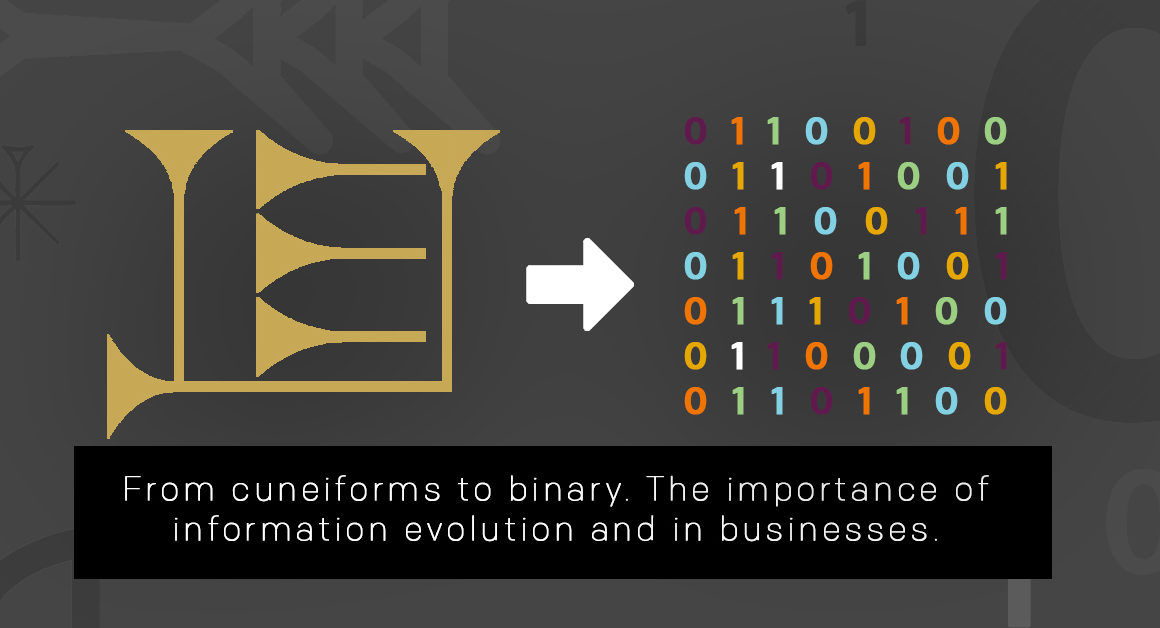The Evolution of Information and Why Some Businesses Continue to Lag Behind

If you are reading this on your tablet you should be grateful that a tablet in today’s world is not the same as what a tablet meant a few thousand years ago. Once upon a long time ago, the way our ancestors shared and communicated written information included all sorts of inconveniences such as waxed tablets, clay, papyrus, wood, and slate.
Of course, we have a come a long way since with a series of transformation in information that has seen us evolving away from clay to parchment (animal skins) to paper and to, what we now see today, digital.
One of the earliest-known writing systems dates back over 5000 years ago by the Sumerians, an ancient civilization in modern-day’s Iraq, that used a writing system called cuneiform. These clay tablets had been essential in information as they became instruments for trade, accounting, administrations, and contracts—so important that this system outlived the Sumerians.
It wouldn’t be until around 3500 years later that paper would be invented in China. Along with the printing process, this would become the biggest technological advancement that the world had ever seen. It revolutionized the way information could be shared across the world as multiple copies could be achieved with simplicity. By between the 13th and 16th centuries, mass printing was able to help spread information on a wider scale in forms such as newspapers, books, and paper documents.
Skipping ahead to just a few decades ago we have seen information evolve once again to the digital realms with information now being spread and accessed easily within the palms of our hands—or on your electronic tablet.
The shift away from clay tablets to paper and now to digital or electronic forms has all had a common purpose, however: the purpose to become more efficient. Being either for personal or business purposes, information or managing of information is essential and therefore needs to be efficient.
“If you always do what you’ve always done, you’ll always get what you’ve always got,” once said by Henry Ford. Ford, a pioneer in technological and innovative advancements, realized that efficiency was crucial in businesses and manufacturing; this also includes the advancement in information.
So, the biggest question then is why haven’t we all converted away from paper and to digital? For the last two decades our dependency in paper has proven that we have a better option with today’s technology.
Paper medical records of patients in hospitals and clinics are still being stored in filing systems that are prime spots that give us paper cuts. Mountains of boxes filled with paper have become natural-forming cubicles between office workers. And don’t forget about the elevated stress levels when Sharon or Steve spills coffee all over last month’s reports.
The impracticability of paper, once a giant leap away from wood or slate, is often debated among executives on the approaches of turning away from paper and to working in electronic formats. One of the most common debates, not surprisingly, include the all-common “costs” debate and the costs of converting to paper documents and records to digital.
Executives should and must realize that business advances have always come from investments in innovation and modernization. One ultimate goal nearly every business tries to achieve is economies of scale, and it has been proven through time that technological advances in business processes must be made in order to achieve more savings in the future.
Costs of working with paper files and documents have inexplicit or costs not immediately obvious. The impracticability is most evident when it comes to multiple employees trying to work on the same hard copy at the same time. With workflows jammed mean more hours being put in by each worker which mean projects dragged along with resources and opportunities lost.
Then, there are storage costs, and this doesn’t just mean storage furniture. Organizations are spending hefty amounts per month on storage rentals for documents and records offsite. The need to access these documents ongoing requires additional transport or courier costs that all in the end eat away at those bottom-line margins.
Lastly, the most feared of all for any business or institution is the vulnerability of paper documents; coffee stains, wrinkled pages, and missing contracts to original hard copies are detrimental to what could have been years of work destroyed.
Our evolutionary journey of information has taken us through a succession of how we manage, share, and access information in a span of within just a few thousand years. With each succession came with an innovational advancement to improve on efficiencies that its last system lagged in.
In today’s world where we depend and demand instant information as conveniently as possible there is no question that hard copy information will one day be extinct. To improve on the exchange of information is evidently a small cost to pay upfront for long-term gains.
But could our shift away from paper to digital be the last stop in our information evolution? Surely, the Sumerians must have once believed that cuneiforms were the most technological advancement. With technologies such as Artificial Intelligence, Machine Learning, and 5G communications the most probable guess is, no.
